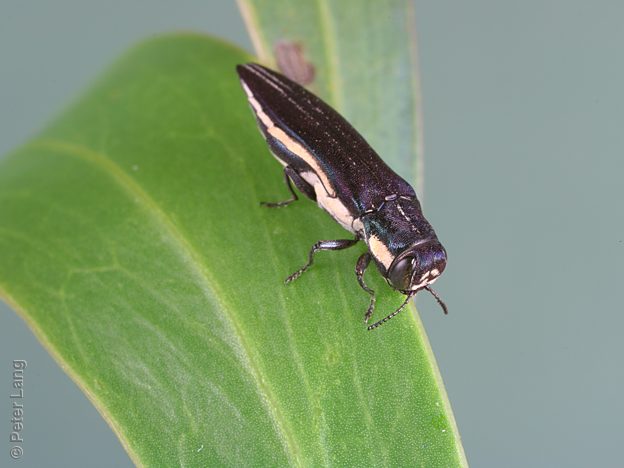
, SL, A2_x468.jpg)
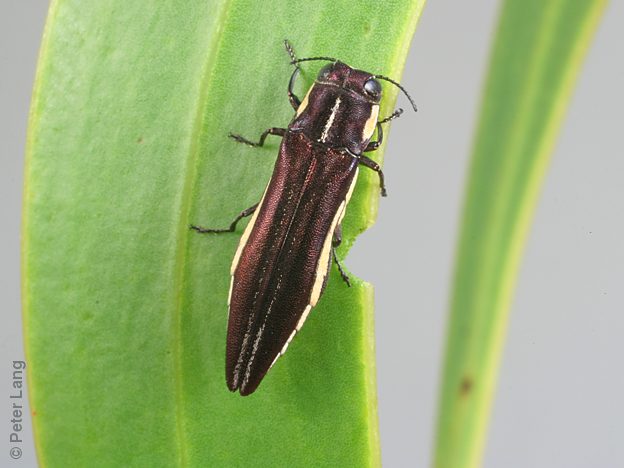
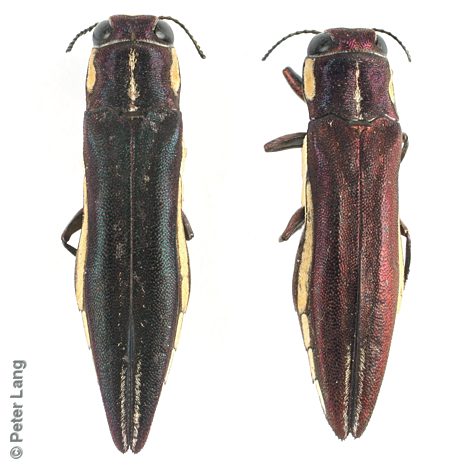
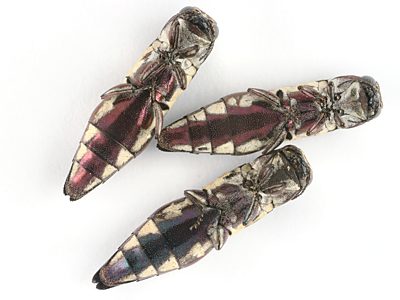
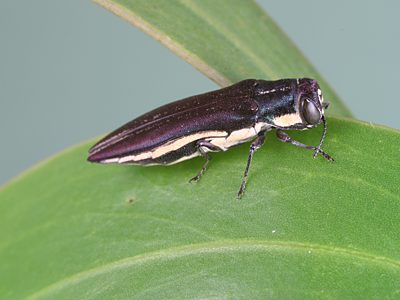
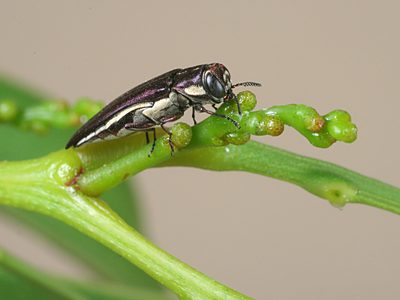
size¹:
×
2.4 mm

, SL, A2_x468.jpg)





| male | female | |||||
|---|---|---|---|---|---|---|
| L1 | 8.7 | 6.3 – 10 | n = 102 | 9.9 | 5.3 – 11.4 | n = 77 |
| L2 | 8.9 | 7.15 – 9.9 | n = 33 | 9.9 | 6.7 – 11.25 | n = 21 |
| W | 2.2 | 1.6 – 2.5 | n = 102 | 2.7 | 1.4 – 3.15 | n = 77 |
| Legend | L1 | length from clypeus/frons to elytral apex (mean, range, sample size) |
| L2 | length from anterior of edge of eyes to elytral apex | |
| W | maximum width with elytra fully closed |
Anterior prosternal lobe with a protruding 'tooth'. First segment on hind feet (metatarsomere) very elongate, especially in males.
This is an extremely common species in SA. Tepper 1887 (on p.20) was most likely referring to this species (and not Agrilus australasiae) when he wrote:
'The larvae live in the bark and splinth wood of the Golden Wattle, even quite young ones, and when present in number sometimes destroy the trees altogether, in fact they would rank among the chief insect enemies of the Wattle (Acacia pycnantha) were they not so eagerly pursued by our native insect-feeding birds'.
| Legend | P.J.Lang collection vouchered records | |
| other private collection or museum specimens, or sightings |
|
|
|
|
|
|
|
|
|
|
|
|
|
||||||||||||||||||||||||||||||||||||||||||||||||
|
|
|
|
|
|
|
|
|
|
|
|
|
||||||||||||||||||||||||||||||||||||||||||||||||
| Jul | Aug | Sep | Oct | Nov | Dec | Jan | Feb | Mar | Apr | May | Jun |
| Legend | live emerged adults, count > median value of 26 per quarter month | |
| live emerged adults, count <= median value of 26 | ||
| live non-emerged adults only, for that quarter month | ||
12 | number of active beetles for that quarter month |
| beetles | sites | SA regions¹ | family | position on host plant | |||||
| Acacia pycnantha | 508 | 48 | FR, EP, NL, MU, SL, SE | F | |||||
| Acacia retinodes | 348 | 15 | NL, MU, SL | F | |||||
| Acacia sp. | 60 | 19 | FR, EP, NL, MU, SL, KI, SE | F | |||||
| Acacia uncifolia | 37 | 7 | SL, KI | F | |||||
| Acacia argyrophylla | 19 | 5 | NL, MU | F | |||||
| Acacia provincialis | 17 | 6 | SL, KI | F | |||||
| Acacia wattsiana | 17 | 3 | NL | F | |||||
| Acacia euthycarpa | 8 | 3 | MU | F | |||||
| Allocasuarina verticillata | 6 | 5 | MU, SL | C1 | |||||
| Leptospermum sp. | 4 | 2 | SL | M | |||||
| Acacia longifolia ssp. sophorae | 3 | 2 | KI, SE | F | |||||
| Callitris gracilis | 2 | 2 | MU, SL | C2 | |||||
| Exocarpos cupressiformis | 2 | 1 | SL | S1 | |||||
| Eucalyptus sp. | 2 | 2 | SL | M | |||||
| Eucalyptus leucoxylon ssp. leucoxylon | 2 | 1 | SL | M | |||||
| Acacia calamifolia | 1 | 1 | FR | F | |||||
| Acacia cupularis | 1 | 1 | SL | F | |||||
| Acacia ligulata | 1 | 1 | MU | F | |||||
| Acacia quornensis | 1 | 1 | EP | F | |||||
| *Acacia saligna | 1 | 1 | SE | F | |||||
| Acacia spilleriana | 1 | 1 | NL | F | |||||
| Allocasuarina muelleriana ssp. muelleriana | 1 | 1 | SL | C1 | |||||
| Dodonaea viscosa ssp. angustissima | 1 | 1 | FR | S2 | |||||
| Eucalyptus fasciculosa | 1 | 1 | SL | M | |||||
| Lepidosperma viscidum | 1 | 1 | NL | C3 | |||||
| Leptospermum myrsinoides | 1 | 1 | SL | M | |||||
| Myoporum insulare | 1 | 1 | SE | S3 | |||||
| Senna artemisioides ssp. petiolaris | 1 | 1 | MU | F | |||||
| Senna artemisioides ssp. zygophylla | 1 | 1 | NL | F |
| Legend | beetles | count of beetles collected from, or sighted on, host plant taxon |
| sites | count of major sites (unique 10 km grid cells +/- some distinct approximate localities) | |
| * | indicates alien (non-native) plant occurrences, either wild or planted (the species may be alien in SA, or native in parts of its SA range) | |
| Plant names in green are hyperlinked to a matching host species page with plant photos. | ||
| Code | beetles | % | host plant taxa | |
| F | Fabaceae | 1024 | 98% | 15 |
| M | Myrtaceae | 10 | 1% | 3 |
| C1 | Casuarinaceae | 7 | 1% | 2 |
| C2 | Cupressaceae | 2 | 0% | 1 |
| S1 | Santalaceae | 2 | 0% | 1 |
| C3 | Cyperaceae | 1 | 0% | 1 |
| S2 | Sapindaceae | 1 | 0% | 1 |
| S3 | Scrophulariaceae | 1 | 0% | 1 |
| position | beetles | sites | ||
| on flower(s) | 7 | 2 | ||
| on flowering plant | 96 | 18 | ||
| on foliage or non-flowering plant | 859 | 65 | ||
| on dead foliage | 1 | 1 | ||
| on plant (unspecified) | 84 | 25 | ||
| other | ||||
| on fruit | 1 | 1 | ||
| unknown | 1 | 1 | ||
| colour | beetles | sites | SA regions¹ | |
| bright green | 4 | 3 | SE | |
| purple-pink | 1 | 1 | SE |
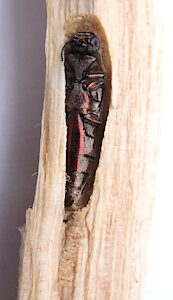
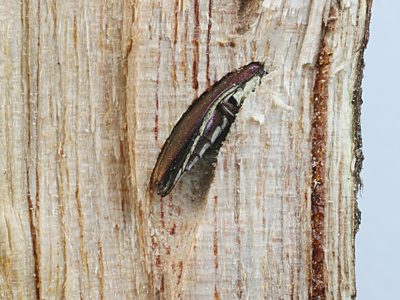
| records | sites | SA regions¹ | family | adult live | adult dead | adult ex billet | adult ex pupa | pupa | larva | |
| Acacia pycnantha | 104 | 9 | MU, SL, SE | F | 9 | 3 | 44 | 18 | 27 | 3 |
| Acacia retinodes | 16 | 1 | MU | F | 1 | 15 | ||||
| Acacia wattsiana | 2 | 1 | NL | F | 1 | 1 | ||||
| Acacia longifolia | 1 | 1 | SE | F | 1 | |||||
| *Acacia pycnantha | 1 | 1 | SE | F | 1 |
| Legend | records | count of breeding adults, pupae and larvae |
| sites | count of major sites (unique 10 km grid cells +/- some distinct approximate localities) | |
| * | indicates alien (non-native) plant occurrences, either wild or planted (the species may be alien in SA, or native in parts of its SA range) | |
| adult | live = extracted alive; dead = extracted dead as intact or fragmentary remains; ex billet = reared and emerged from stored sections of host; ex pupa = reared from sampled pupa | |
| pupa | extracted pupa; pupa ex larva = reared pupa from larva | |
| larva | extracted larva (any stage including prepupa) | |
| gall (only) | hatched or unhatched gall identified by form and position rather than contents | |
| Plant names in green are hyperlinked to a matching host species page with plant photos. | ||
| Code | records | % | host plant taxa | |
| F | Fabaceae | 123 | 100% | 4 |
| position | records | sites | adult live | adult dead | adult ex billet | adult ex pupa | pupa | larva | |
| stem base | 3 | 1 | 2 | 1 | |||||
| stem | 1 | 1 | 1 | ||||||
| dead stem | 120 | 11 | 7 | 6 | 60 | 18 | 27 | 2 |
Adults occur on a variety of Acacia species and in SA they are particularly common on Acacia pycnantha (Golden Wattle) and A. retinodes (Wirilda), where they can sometimes be observed feeding on the foliage (phyllodes). It is known to breed in the live and dead wood of both these species and in A. wattsiana, but probably uses many other Acacia species also. Turner 2001b reported A. longifolia as a larval host plant in NSW with breeding established in dead branches.
| ¹ Legend | regions | SA State Herbarium regions (map) EA: Eastern, EP: Eyre Peninsula, FR: Flinders Ranges, GT: Gairdner-Torrens, KI: Kangaroo Island, LE: Lake Eyre, MU: Murray, NL: Northern Lofty, NU: Nullarbor, NW: North-Western, SE: South-Eastern, SL: Southern Lofty, YP: Yorke Peninsula |
| size | The ellipse is the correct size when printed, indicative on a desktop screen, and likely to be wrong on a mobile device. |